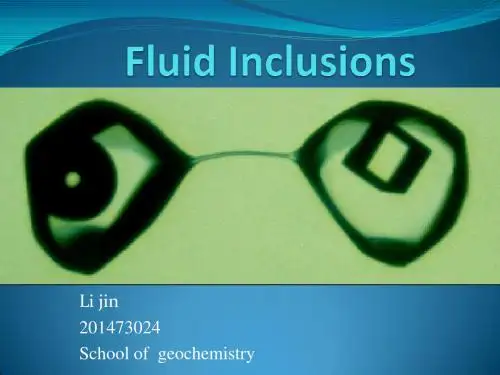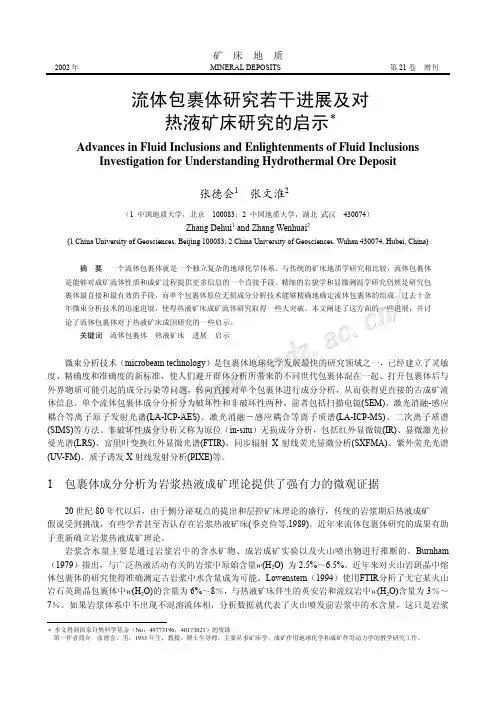fluid inclusions
成因矿物学(矿物的标型性)2

如金刚石原只产于金伯利岩岩筒中,现发现在钾 镁煌斑岩中、基性、超基性岩包体中也有产出,其 中钾镁煌斑岩型金刚石矿床已成为一重要的金刚石 矿床类型。
海绿石:原是海相地层的指示矿物,现在不同 盐度的陆相水体沉积物中也有发现。 3)区域性:有些标型矿物具有全球的适用性, 而有一些只是在某一区域或某一矿床或矿区内适用 ,这是由于当地的构造地质背景决定的。
形成和稳定于某种特定的地质环境,或者只在某一特定的地质作用 中形成的矿物。
特点: 1)矿物的单成因性:
在自然界有些矿物主要趋向于或者只有一种成因。如:铬铁矿主要 产于超基性岩中;斯石英、柯石英专属于高压冲击变质成因(多在陨石坑 和上地幔);辰砂、辉锑矿是低温热液矿床的标志。
2)标型矿物的相对性:
一些是单成因的矿物,在其它成因中也有发现。
5.分布于不同地质时代和不同矿床类型、不同岩石类型中的 矿物同位素组成不同。
如:沉积碳酸盐:δ13C,接近于0值(PDB; 岩浆成因的碳酸盐矿物:δ13C -5.3~-7.0‰; 有机质堆积物:δ13C -24~-29‰; 基性超基性岩矿物组合包裹体中金刚石:δ13C -0.25~-03.44‰ 陨石中有金刚石δ13C -0.58~-0.63‰ 冲击岩中的金刚石δ13C -1.32~-1.87‰
黄铁矿中的Co/Ni:
王奎仁(1989)通过我国65个点,共115件黄铁矿样品的 分析研究指出不同成岩成矿条件下形成的黄铁矿其Co/Ni有一定 的标型特征。 同生沉积:显著小于1,范围0.011~ 0.37 沉积改造:随改造强度而增大,从0.16~0.8到接近于1 沉积变质:随变质程度加深而增大,从1.47~5.75
二、离子占位标型
一些结构复杂矿物中离子占位与其形成时的物理化学条件关系密切。 例如辉石的结构类型受化学成分和温度的控制; 辉石晶体的化学式基本上可用M1M2X2O6表示,X位置通常进行类质 配位数为6,M1位置为Ti4+, Al3+, Cr3+, Fe3+, 同 象代替的是Al, Si 它们占据四面体孔隙,配位数为4,M1M2为八面体孔隙, M2位置为Ca2+, Li+, Na+, K+
fluid inclusion geology

gas
ToC
350
Assuming inclusions are captured at a certain temperature (Tt) and pressure (Pt)
liquid
Pt
Isochore (g/cc)
Critical po
KBar
0.5 0. 95 0.80 0 0. 6
L=V
150 X,Y coordinates can be stored
Max. 15mm motorized X,Y travel Manual & PC operation
Definable sample scan area
7, 10 or 16mm (G7, G10 or G16) sample holders
1.0
liquid
Pt
Isochore (g/cc)
Critical po
KBar
0.5 0. 95 0.80 0 0. 6
L=V
0 50 150
gas
350
Th
Tt
T oC
If the capture pressure Pt is known or can be estimated, you can gain the capture of the inclusions temperature
Li jin 201473024 School of geochemistry
Contents
Introduction
Develpoment
Application Conclusions
Edwin Roedder (1919-2006)
1.What is fluid inclusion ?
高级矿床学8找矿案例斑岩矿床

高级矿床学-斑岩型矿床
斑岩铜矿
h
1
斑岩铜矿(Porphyry copper deposits)为世界提供了 50% 以上的 铜金属(over 100 producing mines)。 Their close relatives the porphyry moly deposits produce 70% of the world's moly. Both deposit types will be discussed separately, but they share many characteristics and are formed in somewhat similar manners.
The deposit occurs in a triangular zone of disseminated and veinlet copper
sulfide mineralization 1.5 x 2.5 km in plan and at least 500 meters in thickness.
典型斑岩铜矿床呈圆筒状,产于岩株状岩体中,出露面 积为1.5 x 2 km (椭圆状),核部为斑岩质,向外到边 部为中—粗粒等粒的成分相似的岩石。
主岩岩石学
一般地,容矿主岩为长英质侵入体,成分为石英正长岩、 石英二长岩、花岗闪长岩系列;闪长岩—正长岩系列
h
4
热液蚀变
Lowell and Guilbert 总结的斑岩铜矿蚀变模式,围绕斑岩株依次出现4个蚀 变晕
流体包裹体

包裹体被冷冻固结—加热开始溶化的系
列照片。Serial photomicrographs of one of a plane of secondary inclusions in salt
from Palo Duro basin, Texas, at the temperatures indicated (°C). On cooling to -135°C and
石英中的次生luid inclusions in anhydrite (Sample 193-1188A-7R-2 [Piece 2, 39-41 cm] in plane-polarized transmitted light; width of view = 0.275 mm.
包裹 体的显微镜观察
合适的放大倍数 包裹体相的识别
❖液相+气相 »液相与矿物界线明显,气相色深, 气泡跳动
❖液体CO2 和碳氢化合物 »31.10的液-固相临界温度 »液体烃类包裹体色黄
包裹体特征记录 ❖充填度 ❖气体百分数 ❖颜色 ❖形状 ❖大小 ❖数量 ❖分布
包裹体特征记录 ❖充填度
F VL 100% VL Vv
❖气体百分数
N Vv 100% VL Vv
❖利用标准图谱进行估算
数量 ❖利用计数器数包裹体 ❖单位面积中包裹体的数量
分布 ❖包裹体成因的重要信息
包裹体测定方法 ❖物理特征分析 »显微热分析法----均一测温法 »爆裂测温法 ❖化学特征分析 »气相色谱 »液相色谱 »激光拉曼光谱 »质谱法
不混溶
❖流体内部不同组成部分热膨胀系数的 差异
子矿物 ❖流体为浓度较高流体 ❖温度下降,溶解度下降 ❖结晶形成子矿物
沿裂隙分布流体包裹体的形成
流体包裹体研究若干进展及对热液矿床研究的启示

张德会1 张文淮2
(1 中国地质大学,北京 100083;2 中国地质大学,湖北 武汉 430074)
Zhang Dehui1 and Zhang Wenhuai2
(1 China University of Geosciences, Beijing 100083; 2 China University of Geosciences, Wuhan 430074, Hubei, China)
2 斑岩铜矿成矿流体和成矿金属均与岩浆热液有密切成因联系
研究表明斑岩铜矿成矿经历了早期岩浆和晚期大气水阶段,但在搬运和沉淀矿石的是早期岩浆热液还 是晚期地下水的问题上还有争论。包裹体研究不仅证明引起早期高温钾质蚀变的是岩浆流体,而且伴随Cu 沉淀的热液也是岩浆热液。斑岩铜矿中的流体包裹体大都是在低于和接近花岗闪长岩固相线的温压条件下 被捕获的,因此不仅那些在相对高温下(t≥500~600℃)均一的高盐度包裹体是岩浆热液包裹体,而且中 等盐度(w(NaCleq)为 10%)、中温(t 为 300~400℃)或低盐度富气包裹体也可以是岩浆热液成因,它们 代表了直接从岩浆中分异或从岩浆中出溶的两种不混溶相。整个斑岩成矿系统垂向上延伸达 10 km,不同 类型包裹体实质代表了不同矿床形成的温压条件(Bodnar,1995)。
俄罗斯一个研究小组经多年研究提出,热液学说不能完全解释金属从岩浆中的分离和富集。Sobolev and Starostin(2001)提出了硅酸盐熔体-卤水流体(Silicate-salt melt-brine)的观点。指出含矿花岗岩中不仅存 在玻璃、液体和气体包裹体,而且存在由硅酸盐熔体和硅酸盐-盐水熔体组成的两相包裹体,或硅酸盐-盐 (熔体-卤水)单相包裹体。在无矿花岗岩中未发现此类包裹体。这些硅酸盐熔体-卤水中盐度w(NaCleq)高 达 70%,富集H2O、F、Cl、B等挥发分,含有高浓度W和Sn的化合物。当这种富金属硅酸盐熔体-卤水上 升到地壳浅部时,与地下水作用,形成通常所称的热水溶液,在稀释过程中形成金属沉淀。这一认识深化 了Marakushev 等(1983)的流体熔体观点。这一观点还得到元素在熔体/溶液之间分配系数(Kpm/v)实验 数据的支持,即在含F的熔体-溶液体系中,W、Sn、Li、Nb、Ta等元素的Kpm/v>1 或远大于。上述认识可以 较好地解释一些石英脉型和花岗岩型稀有金属矿床的形成机理。
1宝石包体的基本知识

11
Comments: Coesite inclusion in garnet of eclogite sample (from: Eur. J. Mineral, 13: 567). Location: Ultra high-pressure metamorphic area of the Saidenbach reservoir, Erzgebirge, Germany, where micro-diamond-bearing gneiss occurs. scale Bar 50 µm
8
同成包裹体中还包括一种假次生包裹体 假次生包裹体:宝石矿物 假次生包裹体 晶体在生长形成过程中由于受不均匀热或力的作用 产生裂开,晶体周围的流体或熔体进入这些裂隙, 后由于晶体继续生长,这些流体或熔体被封闭,形 成假次生包裹体。假次生包裹体可切割主矿物晶体 的早期生长结构,一般不切割主体宝石的晚期生长 带。这种包裹体捕获作用在主体宝石矿物晶体的形 成过程中可重复发生,与一些后期裂隙充填的后成 包裹体在形态上容易混淆。判断假次生包裹体与后 成包裹体的主要依据是观察这两类包裹体的分布, 假次生包裹体在主体宝石晶体的表面没有开口,而 后成包裹体在主体宝石晶体的表面可观察到开口
在主宝石矿物的生长过程中所捕获的包裹体。 它比宝石形成早,在主宝石形成前就已形成。 在宝石包裹体中主要指固态包裹体。 如:发水晶、日光石、祖母绿中的云母、方解石等。
4
主晶(Host crystal):也叫寄主晶体或宿主 主晶 晶体,一般特指可包裹其它物质的主体晶 体; 客晶(Guest crystal):也叫客体,一般特指 客晶 被包裹的矿物晶体。一种矿物既可以是主 晶,也可以是客晶。如磷灰石,在石榴石 中其作为包裹体出现时为客晶,作用宝石 时,其可以包裹其它矿物如锆石,方解石 等,这时它又是主晶。
成矿流体地球化学
表2 云南腾冲地热区深层热水化学组成
因此,高温成矿流体主要与岩浆、火山或 高级区域变质作用有关,岩浆及高级变质 作用热流可以驱动各种地质流体演化为高 温Si+K成矿流体
2.中温碳酸盐型卤水
(1)概念
中温并富含Mn2+、Fe2+、Mg2+的碳酸盐化合物的 成矿流体-又称热水溶液(epithermal solution)
成矿流体的形成主要与地质作
用有关,是流体在特定环境、 特定演化阶段形成的特征产物
自然界中由单一起源的成矿流体的成矿 作用是极少发生的,在各种地质作用中 不同来源的流体会互相混合并与岩石发 生反应,成为新的流体类型或成矿流体
四、成矿流体地球化学特征
一般成矿流体都是富含挥发份、卤素及不 相容碱金属、碱土金属元素的流体溶液
地球化学研究表明,高F流体中,硅质经常 以SiF4的形式存在,这样明显增加了硅质的 溶解度
前人大量成矿流体研究发现,含F 矿物更 多产于高温热液矿床中,如云英岩、伟晶 岩、夕卡岩、钾质岩浆热液矿床中 F 在冰晶石、铁锂云母、黄玉、磷灰石、烧 绿石、香花石、硅镁石等矿物中置换OH-、 O2-进入矿物晶格。
这一特征与成矿作用中的高温钾化、硅化、 萤石化及电气石化蚀变(alteration)及热水沉 积作用(epi-thermal sedimentation)特征是一致 的
②一般高温Si+K卤水的形成与岩浆作 用或变质作用有关,由于充分的水-岩 交代作用,可以获得较高的温度及足 够的溶质组分
③热水沉积成矿研究资料表明,高温(中温) 卤水中SiO2和K2O丰度很高,并总是与高温 型(中温型)热液交代或热水沉积矿化有关
亚洲流体包裹体国际会议ACROFIVII
第七届亚洲流体包裹体国际会议(ACROFI VII)(第一号通知)Asian Current Research on Fluid Inclusions(亚洲流体包裹体国际会议),简称ACROFI,是由国际矿物学会倡议召开的,与ECROFI(European Current Research on Fluid Inclusion)(欧洲流体包裹体国际会议)和PACROFI(Pan American Current Research on Fluid Inclusion)(泛美流体包裹体国际会议)并列的国际会议。
自2006年5月首届ACROFI在中国南京成功举办后,ACROFI每两年在不同国家定期召开,分别是2008年11月印度克勒格布尔(ACROFI II),2010年9月俄罗斯新西伯利亚(ACROFI III)以及2012年8月澳大利亚布里斯班(ACROFI IV)、2014年5月中国西安(ACROFI V)、2016年11月孟买(ACROFI VI)。
第七届流体包裹体学术研讨会(ACROFI VII)再次回到中国,将于2018年9月11~17日在中国首都北京市举行。
届时会议将为亚洲和世界各国的科研人员提供一个最新研究成果的国际交流平台。
热忱欢迎各位专家、同行踊跃投稿,积极参加!热忱欢迎各企、事业单位提供研讨会赞助、参加会展、发布信息!请有意者与组委会联系。
一、会议组织方式与主要议题会议以大会报告、分会场专题报告和展板形式举行,分会场根据参加人数和参加会议的论文分组组织,会议语言为英语。
大会报告30分钟,专题报告20分钟。
图板尺寸不超过80cm*120cm。
口头报告及图板展示的具体日程安排将于第三号通知中以E-mail形式发出。
会议主要议题包括:(1) 岩浆作用与熔体-流体演化过程;(2) 变质作用与流体分异;(3) 浅部流体、盆地流体活动与油气成藏;(4) 成矿流体活动与巨量元素迁移-富集;(5) 地质流体分析技术最新进展;(6) 地质流体岩相学模拟;(7) 流体及熔体包裹体新领域研究。
流体包裹体在油藏地球化学中的应用
收稿日期:2004-02-17作者简介:马安来(1969-),男,副教授,现为中国石化勘探开发研究院博士后,从事石油地球化学研究与教学工作。
文章编号:1009 0207(2004)02 0001-04流体包裹体在油藏地球化学中的应用马安来1,2,金之钧1,张大江3(1.中国石化石油勘探开发研究院,北京;2.长江大学,湖北荆州434102;3 中国石油勘探开发研究院,北京,100083)摘 要:流体包裹体在油藏地球化学研究中有着重要的应用价值。
含油包裹体丰度GOI 可以确定古油水界面,包裹体均一化温度可以确定油气藏形成时间,包裹体分子组成可以反演油藏的充注历史,冰点可以确定地层水的演化及确定油藏储量。
此外流体包裹体还可以确定油气藏的演化程度、油气运移通道及盆地异常压力的研究中。
文中还提出了研究中存在的问题及努力的方向。
关键词:流体包裹体;含油包裹体颗粒GOI;包裹体分子组成MCI;均一化温度;冰点;油气藏中图分类号:TE122.1 文献标识码:A 流体包裹体是地质流体研究的一个重要组成部分,它分为熔融包裹体和气液包裹体两大类。
有机包裹体是气液包裹体的一种特殊类型,由有机的液体、气体和固体组成,液体如石油,气体如甲烷、乙烷等,固体如沥青。
B urruss[1]称这类包裹体为碳氢流体包裹体或烃包裹体。
研究表明,只要沉积物发生重结晶作用,就能在晶体中形成包裹体。
由于流体包裹体不仅记录了沉积成岩流体的成分、温度、压力等信息,同时也记录了盆地油气生成和演化信息,因而在油藏地球化学研究中有着重要应用价值。
1 GOI (grain with oil inclusions,GOI 值)及古油水界面的确定GOI 技术是澳大利亚联邦科学与工业研究机构(CSRIO)石油资源部的专利技术,可以确定古油水界面。
石油在运移进入砂体时,由于毛细管阻力不同,将优先流过最大的孔隙喉道。
如果没有阻止流动的屏障,毛细管阻力将把石油限制在最大的相互连通的网络中,仅有相当少量部分的孔隙暴露于石油中,研究表明经过运移路径的非均质孔隙介质的含油饱和度(S 0)很少超过1%~2%,仅有横切运移带的少数颗粒捕获油包裹体;如果石油柱压力高,则会克服毛细管阻力,使石油流入更小的孔隙喉道中,含油饱和度增加,在与稳定石油柱存在相一致的高含油饱和度的条件下(S 0为40%~90%),大多数孔隙将暴露于石油中,因而多数颗粒将会捕获油包裹体,即使现今岩石为水湿的或气饱和的,古石油柱也可以用流体包裹体中捕获的烃类加以确定。
地质词典
英文地质书刊中常用词组Aa bit of 一点,少量的above all 尤其是,最重要的是according as 依照,随。
而定according to 依照,根据account for 说明,解释act as 起。
作用,担任act(up)on对。
起作用a few 有几个,有一些after all 毕竟,终究a good(great)deal of 很多a good(great)many of 很多agree to 答应,承认agree with 同意。
的意见,与。
一致a little 一点;一会儿all at once 突然all but差不多,几乎,都all over 到处;完全;结束all over the world全世界all the same完全一样,依然all the time始终,一直all the while始终,一直all through从头到尾,始终along with与。
一道;随着a lot of大量,许多amount to总计,等于and so forth等等and so on等等and the like等等answer to符合,与。
一致a number of若干apart from 除。
外,且不说as a matter of course当然的事as a matter of fact 实际上,其实as a result结果as a result of由于。
结果as a rule通常as a whole整个说来as concerns至于,关于as early as 早在a series of一系列as far as远至,到。
程度;尽。
所as far as。
be concered就。
而论,对。
来说as far as。
goes就。
而论as far back as早在。
(就),远在。
(就)as follows 如下,如下所述as for至于,就。
而论as good as和。
- 1、下载文档前请自行甄别文档内容的完整性,平台不提供额外的编辑、内容补充、找答案等附加服务。
- 2、"仅部分预览"的文档,不可在线预览部分如存在完整性等问题,可反馈申请退款(可完整预览的文档不适用该条件!)。
- 3、如文档侵犯您的权益,请联系客服反馈,我们会尽快为您处理(人工客服工作时间:9:00-18:30)。
The application of fluid inclusions in the mineralizationlijinThe department of geochemistry,Yangtze universityAbstract. Fluid inclusion analysis is an important tool in modern studies of mineral deposits, as reflected by the statistics indicating that about a quarter of the papers published in Economic Geology contain fluid inclusion studies. Fluid inclusions play an important role in the classification of mineral deposits and in the study of the composition, temperature and pressure of mineralizing fluids. Among the principal mechanisms of ore precipitation, flu-id phase separation and fluid mixing derive their key evidence mainly from studies of fluid inclusions. Data on mineralizing fluid composition obtained from fluid inclusion analysis are key to understanding how metals were transported in hydrothermal fluids. Recent progresses in metal transport in vapor have been mainly contributed by fluid inclusion studies. Data on fluid temperature and pressure from fluid inclusion studies provide important constraints on hydrodynamic models of mineralization. Most metal ore deposits are formed in the geological fluid.The formation and characteristics of hydrothermal ore deposits are closely related including temperature, pressure and composition. Although these information can be gained through the study of macro geological characteristics of ore deposit and the geochemical characteristics of the mineral , but the composition of ore-forming fluid, temperature, and pressure from fluid inclusion is the most direct evidence.Fluid inclusion is the only remain in ancient ore-forming fluid. So, the study of fluid inclusion becomes one of the important ways of genesis research naturally. For Economic Geology sampling survey, the proportion of fluid inclusion research papers, from 5% in 1975 to 15% in 1985, 27% in 1995, then remained at about 25%, about 1 in 4 papers of deposits essay involves the study of fluid inclusions. Although the fluid inclusion research has expanded to petroleum geology, magma, and the earth's interior processes, etc.its mian application in the field of ore deposit research . The application of fluid inclusions in ore deposit has a lot of monographs. but these works focus on basic principles , methods of the study and the characteristics of different deposit types.This paper mainly discusses the application of fluid inclusions in the study of ore deposits.Keywords: geochemistry, fluid inclusions, hydrothermal deposits, mineralizing fluids, ore precipitation, metal transportation.1.Fluid inclusion is one of the basis of the classification of the ore deposit According to the geological characteristics and genesis, ore deposit can be divided into different types, But at present very few scholars classify the ore deposits completely according to the geological characteristics, such as shear zone gold deposits, stratabound lead-zinc deposit or causes such as high temperaturehydrothermal, the warm liquid, syngenetic and epigenetic[1.2]. Usually the geological characteristics of the ore deposit formation and formation process environment together will be classified as a certain type, whose name can be geological features, such as jet formation process Pb-Zn- SEDEX , or typical areas such as Mississippi V alley-type Pb-Zn MVT[3.4.5], implicit in each deposit type in both the geological characteristics also causes. Different types of ore deposits formed in different geological environment, the inclusion features are different, so fluid inclusions can be used as the basis for identifying ore deposit types. For example , For the most part orogenic type gold deposits containing CO2--H2O with low salinity inclusions; Porphyry copper deposits in salt crystal with high salinity inclusions and the gas phase characteristics of inclusions; Hypabyssal are low salinity inclusions with low temperature hydrothermal deposit of aqueous inclusions; MVT deposits inclusions generally has high salinity but excluding crystal with more H2O – NaCl-CaCl2 system. Different types of inclusions characteristic Deposits are discussed in the relevant papers. It should be noted that, although the inclusions deposit types can be used as the main basis for the division, but not the sole basis. For example, the CO2-rich inclusions is most common in orogenic gold deposits, but in the pegmatite deposits associated with tungsten-tin deposits in other types of deposits are very common. Conversely, it is more effective to exclude certain deposit type with the inclusion features. For example, epithermal deposits should not turn out to be high-density CO2-rich inclusions.This paper, using gold deposits as example, attempts to setup a scientific linkage between ore geology and fluid inclusions[6],considering that in previous published works, observations and measurements of the fluid inclusions commonly were not well interpreted. In some cases, geological data did not agree with the results obtained from fluid inclusion studies. In this paper, we first review previous classifications of gold deposits,and then,subdivide gold deposits into five classes,based on the dominant ore-formingprocesses:1intrusion-related hypothermal systems,such as porphyry-systems, breccia-pipes, IOCG and skarns; 2orogenic- or metamorphic hydrothermal type; 3epithermal-type, i. c. reworking hydrothermal deposits hosted in continental-faciesvolcanic-subvolcanicrocks;4)fine-graindisseminatedtype(Carlin type and/or Carlin-style ,i. e. reworking hydrothermal deposits hosted sediments; and 5hydrothermal metalliferous sediments related to submarine venting, such as VMS and SEDEX styles. In this work we select diagnostic geological and fluid-inclusion characteristics of these five classes of ore-systems,and clarify their key differences that can be used as genetic markers. Ore-fluids are classified into three end-members,namely reworking, metamorphic and magmatic fluids. Many ore-systems are known to form as a result of multiple fluids during multi-stage events; and their late-stage of mineralization always being caused by fluids with a high-proportion of reworking of the original ore systems or by renewed fluid flow. Therefore,the features of late-stage fluids,alteration and mineralization cannot be used to identify the origin and genetic type of an ore-system. Instead,we suggest that only the early-stage signatures can be employed to determine the origin and type of an ore-system. Reworking fluids are characterized by low-temperature(<3000C),low-salinity and low-content of CO2,andsourced from meteoric and/or sea water; metamorphic fluids by moderate-temperature, low-salinity and high-content of CO2;and magmatic fluids by high-temperature,high-salinity and high-content of CO2. Magmatic hydrothermal ore-systems contain multi-daughter-crystal-bearing and high-salinity, C02-rich fluid inclusions; metamorphic ore-systems contain low-salinity, C02-rich fluid inclusions; and the reworking hydrothermal ore-systems contain neither daughter-crystal-bearing nor C02-rich/bearing fluid inclusions,but are populated by aqueous water-solution fluid inclusions. Finally, we discuss the tectonic settings of the ore-systems of the various classes. For examples, the orogenic-type formed during processes of crustal compression, orogenesis,metamorphism and uplift; submarine metalliferous sediments developed in the setting of rift basins; Paleozoic or earlier epithermal-type ore-systems can be preserved in accretionary orogens. It is suggested that the ore-systems and their fluid inclusions can be used as an ideal probe to trace geodynamic evolution of continents.2.The restriction of fluid inclusions to metallogenic conditionsStudy of ore deposit forming condition, the most important thing is toacquare the ore-forming hydrothermal composition, temperature and pressure[3.5]. In this regard, fluid inclusions has an irreplaceable role.In Economic Geology journals, the vast majority of papers related to inclusions belonging to the study of hydrothermal mineralization composition, temperature and pressure. In all geochemical methods of the chemical composition of the ore-forming , fluid inclusions is most direct and effective way of the chemical analysis.The main component of the ore fluids can be measured by laser Raman measurement methods together with microthermometry of fluid inclusions, the minor components and trace components can be measured with different methods of analysis.Isotope thermometer and temperature of fluid inclusions are the main determination of mineralization temperature. Isotope geological thermometer has the advantage of calculation of the pressure, the disadvantages are that it is difficult to separate evaluation mineral of isotope equilibrium and the single mineral separation more time-consuming .The method of inclusion thermometry is direct and simple, but the measured temperature is the lowest homogenizationity temperature . In most cases such as aqueous inclusions, homogenization temperature and trapping temperature are very close, and homogenization temperature that is usually considered ore-forming temperature, there is no need for the pressure correction.homogenization temperature is whether effective related to the basic principles of fluid inclusions microthermometry.The effectiveness of the fluid inclusions analysis depends on three basic assumptions, namely Roedder three principles, inclusions capturing a single, homogeneous fluid phase, the volume of inclusions unchanged , the composition of inclusions from unchanged . If any one of these three conditions is not met, the data of inclusions is invalid. it is difficult to determine whether the volume of inclusions and composition have changed ,because we cannot know the size and composition accurately.it is more difficult to determine pressure on the fluid than mineralization temperature. Although theoretically uniform as long as the measured temperature and compositionof inclusions, you can calculate the density of the fluid, and then calculates the isochore. with isochore, then know mineralization temperature by isotope thermometer, you can calculated pressure. However, due to the constant volume aqueous inclusions line slope of a large space in the temperature and pressure, small temperature difference can cause great pressure error. The isometrc slopes of oil inclusions , CO2 and CH4 are small, which we can use to estimate the pressure.3 .Fluid inclusions are key evidence of mineralization processThe study of fluid inclusions in some ore-forming process is the key evidence[6.7.8]. As is well known, the main mechanism of mineral deposits, the understanding of fluid mixing and fluid phase separation mainly come from fluid inclusions , which is one of the important contributions for modern metallogenic theory.Many of the main mineralization and magmatic intrusion related deposits occur in the contact zone . The reason is that ore-forming fluid pressure drops into the contact zone from rock mass caused by fluid phase separation. A large number of high salinity water solution containing crystal inclusions with homogenization into gas phase inclusions symbiosis has become a porphyry copper ore belt . Many gold deposits in orogenic type are thought to be caused by the pressure in the shear zone and its cyclical fluctuation H2O- CO2 fluid is caused by the phase separation, whose main basis is also from the fluid inclusions. Many of deposits found in hydrothermal of sedimentary basins such as the Mississippi valley Pb-Zn deposit, the main mineral deposits require H2S from sulfate by hydrocarbons in the basin fluid reduction of the product or the result of ore-forming fluid through the ancient reservoirs.Although this evidence can come from stable isotopes and formation of organic geochemical studies, the most convincing evidence is from fluid inclusions.Through fluid inclusions studies we can find deposits have a lot of oil inclusions, and the sphalerite has numerous small oil inclusions along with the distribution of growth rings.4 .Fluid inclusions revealling the methods of mineral transportationIn ore-forming hydrothermal metal, its main form is complex dissolved and Cl- is one of the most important complex anion[9.10].This realization comes from the experiments of high temperature and pressure, but the study of fluid inclusions salinity data is also a very important factor. Fluids are aubiquitous transport tmedium for heat and matter in most geological process. The presence of fluids in rocks may affect the chemical and physical properties, mineral reaction velocity and heatbudget of geological systems, Direct sample of geological fluids could be preserved only in fluid inclusions thatwere trapped during the growth of their host minera.l Fluid inclusions can provide us unique information for the presence and composition ofancient fluidswhich can notbe obtained by othergeochemicalmethods (e.g. the componentand evolution ofdiagenetic fluid; process of fluid-rock interaction; migration of trace elements in fluid). The study offluid inclusions thushasbecome one of the/hottest0fields in earth sciences, and plays an importantrole in studiescorrelated with geologicalprocesses.Startingwith a general introduction to the fluid inclusion properties and a summarization about the classification ofprimary-and secondary-fluid inclusions, thispaper reveiws themostrecentde-velopment in analyticalmethods in the fluid inclusion research field. We also review the currentapplication of fluid inclusions to various fields in earth sciences (e.g.metamorphic fluid, ore-deposi,t petroleum geology and biomarker).5. The restriction of fluid inclusions to metallogenic fluid dynamicsThe formation of hydrothermal ore deposits involves many complex chemical process.Here is an example to illustrate the restriction of fluid inclusions to metallogenic fluid dynamic s[7.8.10].The Lanping Basin, Y unnan Province, South-west China, contains the giant Jinding Zn-Pb depositand the newly discovered Baiyangping Cu-Co-Ag super-large deposit. The Jinding deposit, with reserves of ~200 Mt ore, grading 6108% Zn and 1129% Pb (i.e. metal resources of ~15 Mt) is the largest Zn-Pb deposit in China. The ore is hosted by Cretaceous and Tertiary terrigenous rocks. The Jinding is also the youngest sedimentary rock-hosted and the only continental super-large Zn-Pb deposit in the world. Differing from other major types of sediment-hosted Zn-Pb deposits in the world, including SST, MVT and SEDEX, the Jinding deposit represents a new type of sedimentary rock-hosted Zn-Pb mineralization. Most previous studies assumed that the mineralizing fluids were derived from within the basin and that the fluid flow was largely driven by topographic relief under a hydrostatic regime. However, the observations of hydraulic fractures and fluid inclusion data in this study indicate that the mineralizing fluid system was strongly over-pressured. The study of fluid inclusions in sphalerites and associated gangue minerals (quartz, celestite, calcite and gypsum) shows that homogenization temperatures cluster around 110-150e, with salinities of 1.6-18.0 wt% NaCl equivalent.The fluid temperature increased with the decrease in salinities during the main ore stages, and there is also a systematic westward decrease in temperature and increase in salinity in the Jinding ore district. Fluid pressures as high as (513-1364)×105Pa are indicated by CO2-rich fluid inclusions. The results of basin fluid dynamicmodeling indicate that the overpressures could not have been produced by normal sediment compaction, and the overpressure related to the thrusting may be inadequate to explain the high fluid pressures indicated by fluid inclusions. The injection of mantle-derived fluids is thought to be a viable mechanism for the build-up of high overpressures. The mixing of two types of fluids in a structural lithologic trap may have been the key dynamic process for the large-scale mineralization in the Lanping Basin: one was a mantle-derived fluid enriched in metals and CO2with higher temperatures and lower salinities, and the other was H2S-rich saline formation water with lower temperatures and higher salinities. The special hydrodynamic regime and potential contribution of mantle-derived fluids to the mineralizing system distinguish Jinding from other known sedimentary basin-asso-ciated Pb-Zn deposits.6.ConclusionsFluid inclusions as the sample of mineralization of ancient fluid ,it playsirreplaceable role in the study of ore deposit compared with other methods. Simple petrography observation can provide important basis for the division of ore deposit types. The fluid inclusions can provide the information of composition, temperature, pressure and important parameter; For some ore-forming process, such as fluid phase separation and the fluid mixing, fluid inclusions can provide the most direct evidence; Fluid inclusions play an important role in the study of mineral transportation; In recent years, the acknowledgement of metal moving in the gas phase mainly come from fluid inclusions; Fluid inclusions can provide the temperature , pressure data and important constraints for the ore-forming fluid dynamics model. Therefore, the fluid inclusions have important contribution to the theory of modern mineralization. References[1] Bodnar R J. 2003a. Introduction to fluid inclusions. In: Samson I, An-derson Aand Marshall D, eds. Fluid inclusions: Analysis and inter-pretation[M].Mineralogical Association of Canada, Short CourseSeries, 32: 1-8.[2] Bodnar R J. 2003b. Reequilibration of fluid inclusions. In: Samson I,Anderson Aand Marshall D, eds. Fluid inclusions:A nalysis and interpretation [ M].Mineralogical Association of Canada, ShortCourse Series, 32:213-231.[3]Chi G X and Lu H Z. 1991. Characteristics of fluid phase separationfields indepth-temperature coordinates with emphasis on their sig-nificance on localization of hydrothermal deposits [ J ]. ActaMineralogica Sinica, 11: 355-362 [4]Chi G, Guha J and Lu H Z. 1993. Separation mechanism in the forma-tion ofproximal and distal tin-polymetallic deposits, Xinlu ore field,southern China: Evidence from fluid inclusion data [J]. Econ.Geol., 88: 916-933.[5]Chi G, Savard M M and H†roux Y. 1995. Constraints from fluid inclusion data onthe origin of the Jubilee carbonate-hosted Zn-Pb deposit, Cape Breton, Nova Scotia[J]. The Canadian Mineralogist,33: 709-721.[6]Chi G and Savard M M. 1998a. Basinal fluid flow models related to Zn-Pbmineralization in the southern margin of the Maritimes Basin,eastern Canada[J].Econ. Geol., 93: 896-910.[7]Ulrich T, Gunther D and Heinrich C A. 1999. Gold concentrations of magmaticbrines and the metal budget of porphyry copper deposits [J]. Nature, 399: 676-679.[8] Wilkinson J J. 2001. Fluid inclusions in hydrothermal ore deposits[J].Lithos, 55:229-272.[9]Chi G, Dube B, Williamson K and Williams-Jones A E. 2006. Forma-tion of theCampbell Red Lake gold deposit by H2O-Poor, CO2-dominated fluids[J].Mineralium Deposita, 40: 726-741.[10] Chi G, Xue C, Lai J and Qing H. 2007. Sand injection and liquefactionstructuresin the Jinding Zn-Pb deposit, Y unnan, China: Indicatorsof an overpressured fluid system and implications for mineralization[J]. Econ. Geol., 102: 739-743.。
